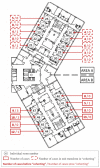Management of a Major Carbapenem-Resistant Acinetobacter baumannii Outbreak in a French Intensive Care Unit While Maintaining Its Capacity Unaltered
- PMID: 35456771
- PMCID: PMC9031073
- DOI: 10.3390/microorganisms10040720
Management of a Major Carbapenem-Resistant Acinetobacter baumannii Outbreak in a French Intensive Care Unit While Maintaining Its Capacity Unaltered
Abstract
We describe bundle measures implemented to overcome a protracted carbapenem-resistant Acinetobacter baumannii (CRAB) outbreak in an 18-bed trauma Intensive Care Unit (ICU) at Strasbourg University Hospital, a tertiary referral center in France. Outbreak cases were defined by a positive CRAB sample with OXA-23 profile during or after ICU say. To sustain the capacity of the busy trauma ICU, infection control bundles were purposely selected to control the outbreak without closing the ICU. During the outbreak, from May 2015 to January 2019, 141 patients were contaminated by CRAB, including 91 colonized and 50 infected patients. The conventional infection and prevention control (IPC) measures implemented included weekly active surveillance of patients' samples, enhancement of environmental cleaning, interventions to improve hand hygiene compliance and antibiotic stewardship with audits. Supplemental measures were needed, including environmental samplings, health care workers' (HCWs) hand sampling, chlorhexidine body-washing, relocation of the service to implement Airborne Disinfection System (ADS), replication of crisis cells, replacement of big environmental elements and improvement of HCW organization at the patient's bedside. The final measure was the cohorting of both CRAB patients and HCW caring for them. Only the simultaneous implementation of aggressive and complementary measures made it possible to overcome this long-lasting CRAB epidemic. Facing many CRAB cases during a rapidly spreading outbreak, combining simultaneous aggressive and complementary measures (including strict patients and HCW cohorting), was the only way to curb the epidemic while maintaining ICU capacity.
Keywords: CRAB; infection prevention and control; intensive care unit; outbreak.
Conflict of interest statement
The authors declare no conflict of interest.
Figures


References
-
- Liu W.-L., Liang H.-W., Lee M.-F., Lin H.-L., Lin Y.-H., Chen C.-C., Chang P.-C., Lai C.-C., Chuang Y.-C., Tang H.-J. The Impact of Inadequate Terminal Disinfection on an Outbreak of Imipenem-Resistant Acinetobacter baumannii in an Intensive Care Unit. PLoS ONE. 2014;9:e107975. doi: 10.1371/journal.pone.0107975. - DOI - PMC - PubMed
-
- Teerawattanapong N., Panich P., Kulpokin D., Na Ranong S., Kongpakwattana K., Saksinanon A., Goh B.H., Lee L.-H., Apisarnthanarak A., Chaiyakunapruk N. A Systematic Review of the Burden of Multidrug-Resistant Healthcare-Associated Infections Among Intensive Care Unit Patients in Southeast Asia: The Rise of Multidrug-Resistant Acinetobacter baumannii. Infect. Control Hosp. Epidemiol. 2018;39:525–533. doi: 10.1017/ice.2018.58. - DOI - PubMed
-
- Barnes S.L., Morgan D.J., Harris A.D., Carling P.C., Thom K.A. Preventing the Transmission of Multidrug-Resistant Organisms: Modeling the Relative Importance of Hand Hygiene and Environmental Cleaning Interventions. Infect. Control Hosp. Epidemiol. 2014;35:1156–1162. doi: 10.1086/677632. - DOI - PMC - PubMed
LinkOut - more resources
Full Text Sources

